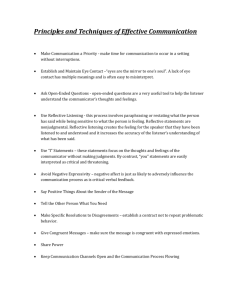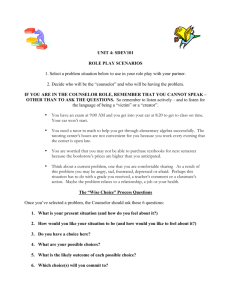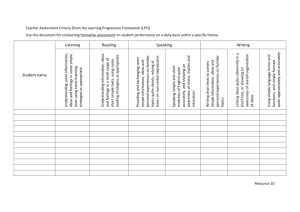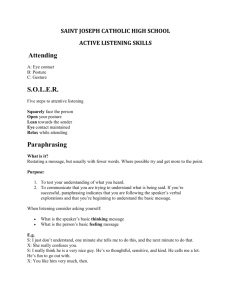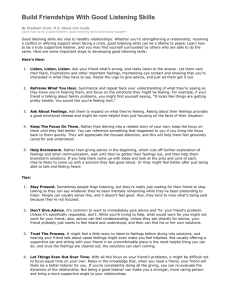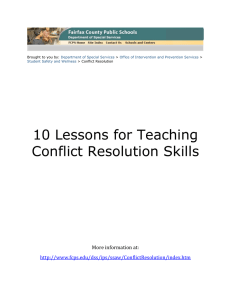helpful communication skills - National Mentoring Partnership
advertisement
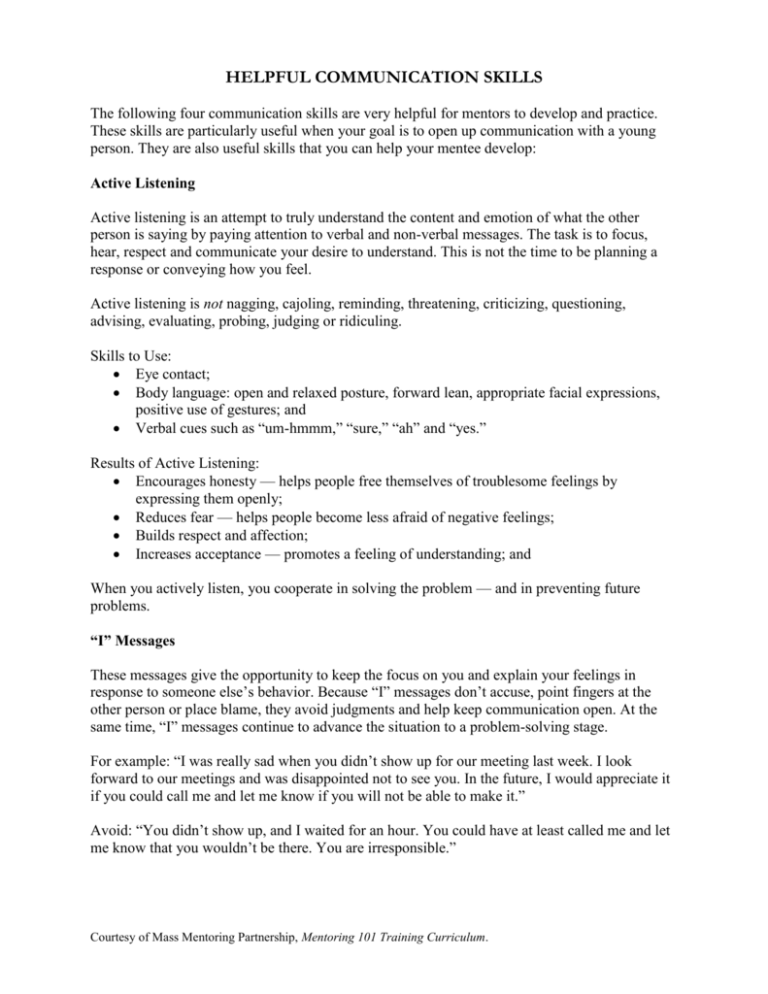
HELPFUL COMMUNICATION SKILLS The following four communication skills are very helpful for mentors to develop and practice. These skills are particularly useful when your goal is to open up communication with a young person. They are also useful skills that you can help your mentee develop: Active Listening Active listening is an attempt to truly understand the content and emotion of what the other person is saying by paying attention to verbal and non-verbal messages. The task is to focus, hear, respect and communicate your desire to understand. This is not the time to be planning a response or conveying how you feel. Active listening is not nagging, cajoling, reminding, threatening, criticizing, questioning, advising, evaluating, probing, judging or ridiculing. Skills to Use: Eye contact; Body language: open and relaxed posture, forward lean, appropriate facial expressions, positive use of gestures; and Verbal cues such as “um-hmmm,” “sure,” “ah” and “yes.” Results of Active Listening: Encourages honesty — helps people free themselves of troublesome feelings by expressing them openly; Reduces fear — helps people become less afraid of negative feelings; Builds respect and affection; Increases acceptance — promotes a feeling of understanding; and When you actively listen, you cooperate in solving the problem — and in preventing future problems. “I” Messages These messages give the opportunity to keep the focus on you and explain your feelings in response to someone else’s behavior. Because “I” messages don’t accuse, point fingers at the other person or place blame, they avoid judgments and help keep communication open. At the same time, “I” messages continue to advance the situation to a problem-solving stage. For example: “I was really sad when you didn’t show up for our meeting last week. I look forward to our meetings and was disappointed not to see you. In the future, I would appreciate it if you could call me and let me know if you will not be able to make it.” Avoid: “You didn’t show up, and I waited for an hour. You could have at least called me and let me know that you wouldn’t be there. You are irresponsible.” Courtesy of Mass Mentoring Partnership, Mentoring 101 Training Curriculum. Take care that the following actions and behaviors are congruent with an honest, open heart: Body language: slouching, turning away, pointing a finger; Timing: speaking too fast or too slow; Facial expression: smiling, squirming, raising eyebrows, gritting teeth; Tone of voice: shouting, whispering, sneering, whining; and Choice of words: biting, accusative, pretentious, emotionally laden. Results: “I” messages present only one perspective. Allowing the other person to actually have a point of view and hearing it doesn’t mean that he or she is right. “I” messages communicate both information and respect for each position. Again, this skill moves both parties along to the problem-solving stage. Paraphrasing Paraphrasing focuses on listening first and then reflecting the two parts of the speaker’s message — fact and feeling — back to the speaker. Often, the fact is clearly stated, but a good listener is “listening between the lines” for the “feeling” part of the communication. Using this skill is a way to check out what you heard for accuracy — did you interpret what your mentee said correctly? This is particularly helpful with youth, as youth culture/language change constantly. Often words that meant one thing when mentors were young could have an entirely different meaning for youth today. Examples for fact: “So you’re saying that . . .” “You believe that . . .” “The problem is . . .” Examples for feeling: “You feel that . . .” “Your reaction is . . .” “And that made you feel . . .” Paraphrases are not an opportunity to respond by evaluating, sympathizing, giving an opinion, offering advice, analyzing or questioning. Results: Using active listening skills will enable you to gather the information and then be able to simply report back what you heard in the message — the facts and the attitudes/feelings that were expressed. Doing so lets the other person know that you hear, understand and care about his or her thoughts and feelings. Courtesy of Mass Mentoring Partnership, Mentoring 101 Training Curriculum. Open-Ended Questions Open-ended questions are intended to collect information by exploring feelings, attitudes and how the other person views a situation. Open-ended questions are extremely helpful when dealing with young people. Youth, teenagers especially, tend to answer questions with as few words as possible. To maintain an active dialogue without interrogating, try to ask a few questions that cannot be answered with a “yes,” “no,” “I don’t know,” or a grunt. Examples: “How do you see this situation?” “What are your reasons for . . . ?” “Can you give me an example?” “How does this affect you?” “How did you decide that?” “What would you like to do about it?” “What part did you play?” Note: Using the question “Why did you do that?” may sometimes yield a defensive response rather than a clarifying response. Results: Because open-ended questions require a bit more time to answer than close-ended questions (questions that can be answered by “yes,” “no,” or a brief phrase), they give the person a chance to explain. Open-ended questions yield significant information that can in turn be used to problem solve. Courtesy of Mass Mentoring Partnership, Mentoring 101 Training Curriculum.
